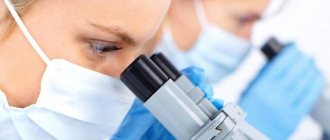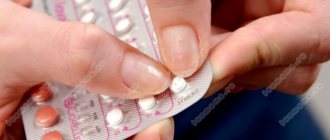Causes of disruption of normal microflora
An imbalance between healthy and pathogenic microorganisms can be caused by many reasons. Among the most common are:
- infections that cause inflammatory processes in the genital organs;
- sexually transmitted diseases (gonorrhea, ureaplasmosis, syphilis);
- changes in life (change of place of residence or climate, long travel);
- intestinal diseases;
- uncontrolled use of antibiotics;
- hypothermia of the body;
- various conditions that provoke disruptions in the hormonal system (puberty, pregnancy, postpartum period, menstrual irregularities, menopause);
- improper use of sanitary tampons during menstruation;
- prolonged stressful situations;
- decrease in the body's defenses.
Including foods containing large amounts of carbohydrates in the diet can also cause disruption of normal microflora. The risk group includes women over 50 years of age and those who are overweight. Often, pathology can be caused by a combination of reasons.
Vaginorm
Vaginorm-S is an antimicrobial and antiseptic agent that improves female microflora. The main active ingredient is ascorbic acid. Its content in 1 suppository is 250 mg.
The product can increase the acidity of the vagina, which prevents further proliferation of pathogens.
At the same time, lactobacilli and bifidobacteria continue their vital activity. In this way, the microflora inside the genital organs is normalized.
Women's pills increase immunity and act as an anti-inflammatory agent.
The doctor prescribes the drug for the following diseases:
- colpitis;
- vaginitis;
- dysbiosis.
It is not recommended to use for candidal colpitis, since increasing the pH can aggravate the situation. There is no need to stop taking Vaginorm during menstruation and infectious diseases. The drug reduces the effectiveness of anticoagulants. You can use women's tablets to normalize microflora during pregnancy and lactation.
The doctor prescribes 1 tablet in the evening for a week.
Side effects may occur in the form of:
burning;
- itching;
- nonspecific discharge;
- candidiasis.
The manufacturer of the tablets is Germany, there are 6 pieces in one package. Approximate price: 620 rubles.
Analogues of the drug:
- Lactonorm;
- Lactobacterin;
- Acylact;
- Vagilak.
Symptoms of biocenosis disturbance
A pathological process is identified when the number of staphylococci, chlamydia, gardnerella or streptococci begins to “displace” beneficial flora. In this case, the woman may feel as usual, and negative changes will be detected after visiting the gynecologist and taking a smear for analysis. But in most cases, violations make themselves felt through a whole spectrum of various negative changes in well-being.
Symptoms of microflora disturbance:
- a sharp increase in the amount of discharge;
- change in the nature of the discharge: its acquisition of an intense yellow color and a specific unpleasant odor:
- feeling of itching and burning in the genital area;
- redness and swelling of the labia;
- feeling of discomfort during sexual intercourse.
In severe cases, inflammatory processes in the genital organs can lead to irregularities in the menstrual cycle and, as a consequence, to the inability to conceive a child. Other complications in the reproductive system are also possible. A significant increase in pathogenic microorganisms causes inflammation of the urethra and bladder, provokes adnexitis and the spread of infection to the appendages.
Treatment is aimed at restoring normal microflora, maintaining an optimal balance of beneficial and pathogenic microorganisms and eliminating unpleasant signs of this disorder. Let us consider in more detail in which cases medication assistance is required.
Pregnancy
Immediately after conception, the body experiences a real hormonal revolution, restructuring its work. This hormonal surge often triggers increased lactic acid production, which in turn increases yeast levels.
An increase in discharge and a change in its color and smell is a common occurrence for an expectant mother. However, this does not mean that the problem does not need to be dealt with. Violation of the flora can lead to miscarriage, infection of the fetus, premature rupture of amniotic fluid and other pathologies. In addition, the normal flora of the mother is the key to the correct formation of the intestines of the unborn child.
Restoring the vaginal microflora during pregnancy is a prerequisite for mothers who care about their health and the proper development of the unborn baby.
On the topic: Urinary tract infections during pregnancy.
Sexually transmitted diseases
Sexual infections are one of the most common causes of disruption of the natural microflora of the vagina. The penetration of infections and the inflammation they cause negatively affect the balance of microorganisms. The situation is aggravated by the fact that in the treatment of such diseases antibiotics are used, which also negatively affect the balance of beneficial and harmful bacteria.
Taking antibiotics
Unjustifiably prolonged or uncontrolled use of antibiotics disrupts the biocenosis of the vagina and intestines. It is especially dangerous when a woman prescribes medications to herself, without first consulting a doctor. The active substances of these medicines are unable to “distinguish” beneficial bacteria from harmful microorganisms. As a result of the death of beneficial flora, a significant imbalance occurs. Restoring normal vaginal microflora after taking antibiotics is a mandatory step in antibacterial therapy.
Disturbance of microflora as a result of thrush
Thrush (bacterial vaginosis) develops due to the death of lactobacilli and the predominance of pathogenic fungi Candida in the flora. Violations of the acid-base balance are treated with antibiotics, but they, as already mentioned, also kill beneficial flora.
After the end of therapy, there are often cases when the number of beneficial bacteria has not yet returned to normal. In addition, thrush has a tendency to recur. Thus, restoration of the vaginal microflora after treatment of thrush involves the colonization of beneficial bacteria.
Why does a woman need probiotics?
The content of the article
Gynecological probiotics are live microorganisms (bacteria or yeast), which, when used in appropriate concentrations, have a positive effect on health by regulating the microflora of the human body.
The most famous probiotics include lactic acid rods (Lactobacillus). They play an important role in a woman’s body, being the most important microorganism that is part of the physiological vaginal flora. Lactobacilli make up about 96% of the vaginal biocenosis in a healthy woman.
Lactobacilli are responsible for maintaining the acidic pH of the vagina (3.8–4.2), creating a protective barrier against pathogens, since most of them cannot grow effectively at low pH. The consequence of a deficiency of lactic acid rods is the development of intimate infections, primarily bacterial inflammation of the vagina (bacterial vaginosis).
Vaginal pH levels at different stages of a woman’s life
Preparations for restoring vaginal microflora
When faced with negative manifestations of the disease, many girls may take extreme positions. Some believe that the illness will go away sooner or later and do not seek medical help. Others begin to take various medications or use folk remedies on the advice of relatives and friends. Both of them are doing the wrong thing.
The process of restoring normal microflora is quite long and proceeds differently for each patient. Only contacting a gynecologist will help solve the problem effectively and in a short time. Self-medicating or ignoring a pathological condition is equally dangerous.
When choosing medications, doctors are guided by test data, the woman’s general condition, information about previous diseases, and the severity of symptoms. The combination of this data allows us to select the most optimal medications.
Products for restoring flora balance are available in the following forms:
- vaginal suppositories – fight pathogenic flora, regulate and support immunity;
- vaginal capsules and tablets – prevent the proliferation of pathogenic infections, reduce the acidic environment of the vagina;
- capsules and tablets for internal use – slow down the growth and development of harmful microorganisms, create a favorable environment for the development of lactobacilli;
- gel – relieves inflammation, eliminates itching and burning sensation;
- probiotics – provide the necessary amount of lactobacilli.
In order for the treatment to be as effective as possible, it is recommended to combine suppositories and tablets. In the presence of inflammatory processes, antibacterial agents may be prescribed. In complex therapy, local antibiotics are used, often in the form of tablets, capsules or ointments. Such drugs include Clindamycin, Terzhinan, Trichopolum.
Suppositories (candles)
Vaginal suppositories are among the most common drugs prescribed to restore microflora. Their main advantage is their direct local effect on pathogenic microorganisms. Suppositories are easy to use, have no side effects and can be recommended for pregnant women, as well as during the recovery period after treatment for thrush. Suppositories are effective in restoring vaginal flora during menopause. The active substances contained eliminate dryness and prevent the development of irritation and itching.
Suppositories contain lactobacilli and bifidobacteria in various proportions, which must be taken into account when selecting the drug. Only the attending physician prescribes the drug. Effective drugs include Bifidumbacterin, Lactobacterin, Kipferon, Acylact, Lactocid, Gynoflor, Estriol. The candles are based on fats of vegetable and animal origin, glycerin, and gelatin. The active ingredients are lactobacilli, bifidobacteria, lactic acid, nystatin.
After inserting the suppository into the vagina, it begins to melt under the influence of the internal body temperature. The released active substances penetrate into tissues through blood vessels and have a destructive effect on pathogenic microorganisms.
The course of treatment depends on the drug and the characteristics of the disease. Usually it ranges from 5 to 10 days. 1-2 suppositories are administered per day, usually at night. In some cases, it may be necessary to undergo a second course of treatment with a break for analysis of the state of the flora. During therapy, sexual intercourse should be avoided.
Vaginal suppositories have a minimum of contraindications, but before using them you need to study the instructions. Some drugs are not recommended for the presence of malignant tumors, uterine bleeding, endometriosis, as well as for girls under the age of majority.
Tablets for restoring vaginal microflora
Although tablet forms of drugs are prescribed less frequently than suppositories, they are also applicable in complex therapy. Commonly prescribed medications include:
- Vaginorm S is a product with an antiseptic effect based on ascorbic acid. Active substances suppress the growth of bacteria and normalize the condition of the vagina. Indications for use: dysbiosis, vaginitis. One vaginal tablet is administered per day for a week. If difficulties arise during administration, it is recommended to moisten the tablet with water.
- Ecofemin - contains lactobacilli in its composition, which ensure the normal balance of microorganisms. The drug is approved for use by pregnant and lactating women. The course of treatment is 6 days, it is possible to continue therapy for up to two to three weeks. The usual dosage is 1 capsule twice a day.
- Laktozhinal - vaginal capsules containing lactobacilli. Taking them helps to increase immunity, create an acidic environment to activate one’s own beneficial microorganisms, and prevent the growth of candida fungi. The product is used to prevent thrush, during menopause and pregnancy. Not recommended for girls under 18 years of age.
Preparations for oral use
Vagilak and Vagisan capsules are used for oral administration.
Vagilac capsules have the ability to “populate” the vagina with beneficial microflora and promote their successful engraftment and intensive reproduction. Active substances eliminate pathogenic microorganisms and prevent the development of the inflammatory process.
The capsule is taken during meals with a sufficient amount of water. Dosage – 1 tablet per day, duration of therapy – 2-4 weeks. If necessary, treatment is extended, but in total it should not exceed 6 weeks. The drug is approved for use during pregnancy; moreover, many doctors recommend its use as a prophylaxis against dysbiosis, even if women do not have any health problems.
Vagisan is prescribed for previous infectious diseases, weakened immunity, and during the period of taking hormonal drugs. Take 1-2 capsules per day with meals. Vagisan capsules can be prescribed during antibiotic treatment, but in this case the interval between taking different tablets should be at least two hours.
Gels in treatment
To improve the state of microflora in complex treatment, drugs in gel form are prescribed. Well-known products include Salvagin Gel and Floragin Gel.
Salvagin gel based on lactic acid has antiseptic and antibacterial properties. Its use contributes to:
- suppression of pathogenic flora;
- stimulation of natural resistance to infections;
- restoration of damaged vaginal mucous membranes;
- eliminating itching, inflammation, burning;
- improving immunity.
The contents of the tube are administered while lying down; it is better to do this before bedtime. This introduction contributes to the long-term presence of the gel in the vagina. The tube is designed for one use. The duration of treatment is 5-7 days. A decrease in discharge, itching and burning is noted after just one or two uses.
Usually the next day after the introduction of the gel, a woman notices the appearance of a “curdy” discharge. This is a normal phenomenon, thus the vagina is cleansed of pathogenic flora.
Pregnancy is not a contraindication to the use of the gel. However, this can only be done after consultation with a doctor.
The drug Floragin gel has a similar effect. It is based on bacteria that normalize flora and chlorhexedine, which has an antifungal effect. Release form: bottles with an easy-to-administer applicator. The gel moisturizes well, eliminates discharge and unpleasant odor. The recommended dosage is 1 bottle per day. The best time for administration is in the evening, before bedtime.
How to restore the vagina after antibiotics
Vaginal microflora plays a huge role in a woman’s health. First of all, the health of the female genital organs determines the ability to get pregnant, avoid the development of pathological processes, and secondly affects the emotional and psychological state.
The body has created a normal vaginal flora, which, with minor deviations, is restored on its own. But there are certain factors that greatly upset the balance between the number of beneficial bacteria and pathogens.
These factors mainly include acute and chronic diseases of the genital organs, treatment with a course of antibiotics and stressful situations. Over time, the beneficial microflora of the vagina becomes saturated with pathogenic bacteria, which affects the entire body.
How do antibacterial medications affect vaginal flora?
The composition of the microflora is moisture. 90 percent is filled with lactobacilli and about 9 percent are bifidobacteria. These indicators may deviate slightly upward or downward without affecting women's health.
There are about 1 percent of pathogenic bacteria, these include:
- gardenerella;
- mobiluncus;
- candida;
- coli.
It is they, when the positive microflora decreases, that influence the occurrence of various pathologies, including candidiasis, chlamydia and others.
Let's consider what happens when pathogenic bacteria disrupt the vaginal microflora. Both after taking antibiotics and with pathological diseases, dysbacteriosis occurs in the female genital system.
Bacteria in the vagina
In general, the term dysbiosis of the vaginal microflora refers to varieties of symptoms due to specific diseases. This is how bacterial vaginosis and fungal processes (candidiasis) appear, and when a sexually transmitted infection occurs, the process of chlamydia and other sexually transmitted diseases accelerates.
Most often, dysbacteriosis appears in everyday life during treatment with a course of antibiotics or failure to comply with personal hygiene rules. The state of the beneficial microflora of the vagina is disrupted, and symptoms of dysbacteriosis and thrush appear.
Antibacterial agents in the modern world are prescribed for most viral and infectious diseases. Due to the deteriorating environment, decreased quality of consumed water, food, and the predominance of stress factors, the human immune system weakens.
Therefore, the body cannot independently resist even acute respiratory infections, not to mention serious pathologies such as pneumonia, pyelonephritis, and cystitis.
In such cases, a course of antibiotics is required, the action of which is aimed at destroying pathogenic microbes. But in addition to infection, beneficial bacteria located in the intestines and vagina also suffer after treatment.
If the intestines are affected only by antibacterial drugs taken orally, then local agents that destroy the microflora are used to treat female inflammation.
All this causes symptoms of dysbiosis:
- discomfort in the intimate area after sexual intercourse;
- release from moisture;
- tooth, redness in the intimate organs.
To avoid negative consequences and preserve women's health after completing a course of antibiotic treatment, it is necessary to approach the question of how to restore the microflora of moisture.
Methods for restoring microflora
Restoration of moisture microflora. after a course of antibiotics is quite long, the period of treatment depends on the neglect of the process and the presence of concomitant pathologies.
There are three main stages:
- Destruction of pathogenic bacteria or completion of the course of treatment of the underlying pathology. The initial stage of restoration of moisture microflora. it is necessary to start when there are no factors that led to this condition.
- Restoration of the moisture microflora itself. and saturating it with beneficial bacteria.
- Correction of the immune system of the body as a whole and the walls of moisture. The last two stages are carried out in one period to achieve a positive effect.
First of all, when symptoms appear, it is necessary to determine the state of the microflora and the degree of neglect of the process. The doctor prescribes a moisture smear examination, as well as additional tests to exclude hidden infection and identify microflora disorders.
During the treatment period, it is necessary to abstain from sexual intercourse and, if necessary, treat the sexual partner.
To a greater extent, local means are used to restore moisture microflora. after a course of antibiotics. In addition to suppositories, local procedures using medicinal baths and tampons are also recommended.
Use of medications
In combination with local agents to normalize the microflora, drugs are needed to correct the immune system. Therefore, immunomodulators and vitamin therapy are prescribed. Also, to saturate the body with vitamins, a diet containing large amounts of fruits, vegetables, cereals, and dairy products is recommended.
Often, after taking antibacterial agents, discharge from the moisture is observed, which may mean the development of thrush. Then antifungal agents are prescribed. You can take them either in the form of suppositories in the vagina or in tablet form.
According to their effectiveness, the following drugs are distinguished:
- Fluconazole and its varieties (Diflucan, Flucostat);
- Clotrimazole (Candide B6);
- Nystatin.
Some modern drugs eliminate the signs of thrush in a single dose (Fluconazole).
After candidiasis is cured, vaginal remedies are prescribed to restore the microflora. They contain probiotics that saturate the vagina with lactobacilli.
Popular drugs include:
On average, the course of treatment lasts from 5 to 10 days. It is better to put candles on at night, then the woman will not experience discomfort and the effect will be maximum. During the period of using candles, you must refrain from sexual intercourse and consumption of alcoholic beverages.
An important aspect in the formation of healthy vaginal microflora remains compliance with the rules of personal hygiene. Fermented milk products speed up the healing process. The diet should include yogurt, kefir, and fermented baked milk.
During and after treatment, for control it is necessary to undergo regular tests for research. This will allow you to adjust the treatment method if necessary.
Folk remedies in treatment
In addition to drug therapy, many women are helped by well-known traditional medicine. These include tampons and medicinal baths, which are easy to prepare at home. Tampons are treated with special solutions and inserted into the vagina for several hours or overnight. Here are examples of the most effective recipes:
- Melt two tablespoons of propolis in a water bath, then add 250 g of butter and bring the contents to a homogeneous mass. The prepared tampon is moistened in the cooled mixture and inserted into the vagina for 3-4 hours. During this time, the woman should not perform physical work. Usually, 4-5 procedures will be needed to eliminate the problem; in severe cases, treatment is continued for a week or more.
- After douching, a tampon treated with sea buckthorn oil is inserted into the vagina. The tampon is left overnight, removed in the morning and the genitals are washed with warm water.
- A teaspoon of honey, two tablespoons of aloe juice and castor oil are mixed and applied to a tampon. It must be left in the vagina for 8-10 hours, preferably overnight.
To relieve itching, burning and irritation, medicinal baths are recommended. To warm boiled water add tincture of chamomile, sage, nettle, St. John's wort, linden and other medicinal herbs that have an anti-inflammatory effect.
Before using traditional medicine, you must coordinate their use with your doctor. They can be used as an additional measure and should not replace medication prescribed by a doctor.
Which probiotic should you choose, vaginal or oral?
Currently, gynecological probiotics are available in various forms of release. These are vaginal suppositories, gels, oral tablets, tampons and sanitary pads with eubiotics.
All probiotics must meet strictly defined criteria: safety and effectiveness of use, confirmed by clinical studies. Correct strain identification is also important.
The choice of route of administration depends on the purpose of using the drug, as well as the patient’s preferences. All available probiotic medicines are divided into:
- to oral (tablets for oral administration);
- vaginal (suppositories and capsules).
For enhanced treatment of sexually transmitted infections and inhibition of the growth and development of vaginal pathogens in the initial stage, probiotics that act locally are best suited. The effect of using vaginal suppositories appears quickly in this case.
Both vaginal and oral probiotics have proven themselves to be effective for preventive purposes. The results from taking the pills develop with a delay, but have a long-lasting effect.
Women who are menstruating and visiting swimming pools or public baths are advised to use tampons or sanitary pads with good probiotics.
Tampon with probiotic
Principles of restoring vaginal microflora
For complete recovery, the use of medications alone is not enough. In treatment, it is recommended to adhere to the following rules:
- Follow a special diet.
- Adhere to sexual hygiene (more details in the article at the link).
- Promptly identify and seek medical help if infectious diseases occur.
- Use prebiotics and probiotics after the main course.
- Take antibiotics or hormonal drugs only after consulting a doctor.
- Use condoms for protection.
- Maintain genital hygiene.
- Wear underwear made from natural fabrics, especially in the hot season.
- Avoid using sanitary tampons if you have allergic reactions.
If the vaginal microflora is disturbed due to infectious or sexually transmitted diseases, both partners need to be treated, otherwise relapses of the disease are inevitable.
For what diseases are probiotics used?
Probiotics in gynecology are used both in the prevention of intimate infections and as an aid in the treatment of existing diseases:
- They are prescribed for frequent bacterial and fungal infections of the vagina - candidiasis, trichophytosis, mycoplasmosis.
- Effective for those who have completed treatment and/or are prone to relapse of the disease.
- Special indications for the use of probiotics are a high risk of superinfection in the presence of immunodeficiency.
- Recommended for patients after completion of antibacterial therapy. But during treatment with antibiotics, the use of probiotics is ineffective because antibacterial drugs kill Lactobacillus bacilli.
- Probiotic microorganisms are also used for hormonal contraception, during pregnancy or the postpartum period.
- Such drugs are especially necessary during menopause (menopause), since hormonal changes at this time contribute to the more frequent development of infections.
- Eubiotics should also be taken before and after gynecological operations, after treatment of any diseases of the female genital area to restore the normal physiological flora of the vagina and prevent relapses.
Menopause
Gynecological probiotics can also be prescribed to women with reduced immunity, diabetes, those who often visit public swimming pools (the use of tampons with probiotics is recommended), as well as women who often change sexual partners.
Medicines to maintain normal vaginal flora are necessary for women who use spermicides and combined oral contraceptives.
Reviews
Alla, 28 years old, Kiev: “After working out in the pool, I began to feel burning and itching in the vagina. Heavy discharge began. The gynecologist prescribed Vagikal to restore female microflora. The effectiveness of the drug was observed within 2 days after use. Completed the full course - 14 days. I liked the drug and no more unpleasant symptoms occurred. The gynecologist said that the microflora had been restored. The main thing is that the product is safe and effective. I was also pleased with the price."
Zoya, 46 years old, Perm: “I took a course of antibiotics, after which dysbacteriosis appeared. And not only the stomach and intestines, but also the vagina. I went to the gynecologist and took tests. The doctor said that the female microflora was disturbed. Prescribed Gynoflor. After the first dose I did not feel any effect, but relief came on the third day. When I completed the full course, I forgot about the dryness and itching. The product is good, I recommend it to everyone. The only thing that confuses me is the high price; I wish I could find a cheaper analogue.”
Olga, 37 years old, Murmansk: “I suffered from bacterial vaginosis for several years. The treatment didn't help. The doctor said that problems with female microflora are to blame. Prescribed Bifidumbacterin suppositories. After completing the course, treatment for vaginosis became more effective. I was tested for dysbiosis - the doctor said that the microflora had returned to normal. Now I always keep this drug in the refrigerator.”
Svetlana, 31 years old, Irkutsk: “When visiting a gynecologist, it turned out that the number of leukocytes in the smear was increased. The doctor prescribed Vaginorm. I bought the product and paid about 600 rubles. I read that it contains ascorbic acid. I was disappointed, but decided to try it. She completed a course of treatment for 6 days. I took a smear - no leukocytes were found, but candidiasis appeared. Perhaps this is after the drug. I won’t recommend him to anyone, and I won’t recommend it myself either.”
Elena, 29 years old, Yekaterinburg: “After childbirth, dryness and itching occurred in the vagina. Female dysbiosis appeared, the microflora was disturbed. I kept waiting for it to go away on its own. I couldn’t wait, I went to the doctor. She prescribed women's suppositories Estriol. I read that the drug can increase local female immunity. I was treated for 2 weeks. Every evening I lit 1 candle. Relief came after 5 days. After the full course, the unpleasant symptoms went away. The product is not bad, and also quite cheap. It also helped my mother, who suffered from the same symptoms, only during menopause.”
Estriol
Estriol is a vaginal suppository for women, the active ingredient of which is exogenous estriol. Most often, the drug is prescribed to women who feel a lack of the hormone estrogen. This condition causes dryness and burning in the vagina, disruption in the regeneration of the mucosa and its atrophic changes.
Suppositories restore microflora, help in the division of mucosal cells, and normalize acidity.
Thanks to the action of the female remedy Estriol, local immunity increases, chronic diseases worsen less frequently.
Doctors prescribe female suppositories:
- during menopause;
- for the prevention of genital and urinary tract infections;
- for the treatment of atrophic changes in the vaginal mucosa;
- with urinary incontinence;
- in preparation for surgical interventions on the genitourinary system.
The drug is contraindicated:
- if there is a tendency to allergic reactions to components;
- when blood clots form;
- for cancer;
- with uterine bleeding;
- with liver failure;
- with hyperplasia of the endometrial walls;
- with atherosclerosis;
- after recently suffering a heart attack.
Prohibited for use by pregnant and lactating women.
Side effects include:
allergic reaction;
- nausea;
- disturbances in liver function;
- hypertension or hypotension;
- blood clot formation;
- headache;
- swelling and pain in the mammary glands.
The doctor prescribes 1 suppository at night. The course of treatment ranges from 7–14 days.
Estriol enhances the effect of glucocorticosteroids and also changes the effect of anticoagulants and beta-blockers.
The manufacturer of the drug is the Republic of Moldova. The drug is available in packages of 15 pcs. Approximate price: 230 rubles.
Analogs of women's suppositories Estriol are:
- Ovestin;
- Estrocad;
- Esterlan;
- Klymen;
- Menostar.
Kipferon
Kipferon is available in the form of rectal and vaginal suppositories. It includes:
- interferon;
- immunoglobulin complex;
- Excipients.
Suppositories have an antiviral effect and an antibacterial effect against chlamydia.
The drug fights inflammation and intoxication of the body as a result of the activity of harmful bacteria. Kipferon promotes rapid healing of the mucous membrane, prevents the formation of scar tissue, and improves female microflora.
Suppositories increase local and general immunity of the body. Kipferon helps with cervical erosion. Improves blood circulation in the pelvic organs. Prevents the occurrence of vaginal dysbiosis.
The drug is prescribed by a doctor in the following cases:
with vulvitis;
- for colpitis;
- with chlamydia;
- with genital herpes;
- with cervical erosion.
- with dysbacteriosis.
Used before surgery to reduce the risk of post-operative infections.
Can be used in the second and third trimesters of pregnancy as prescribed by a doctor. Prescribed in the form of rectal suppositories for children under one year of age.
The doctor recommends 1-2 suppositories per day. The course of treatment lasts about 10 days.
Before inserting a suppository into the vagina, it is recommended to remove excess mucus using a cotton swab.
The drug has no contraindications. No side effects were observed.
Kipferon is available in 5 and 10 pcs. packaged. The manufacturer of the product is Russia. Approximate price: 600 rubles.
Analogues of the drug:
- Giaferon;
- Altevir;
- Laifferon;
- Viferon.











